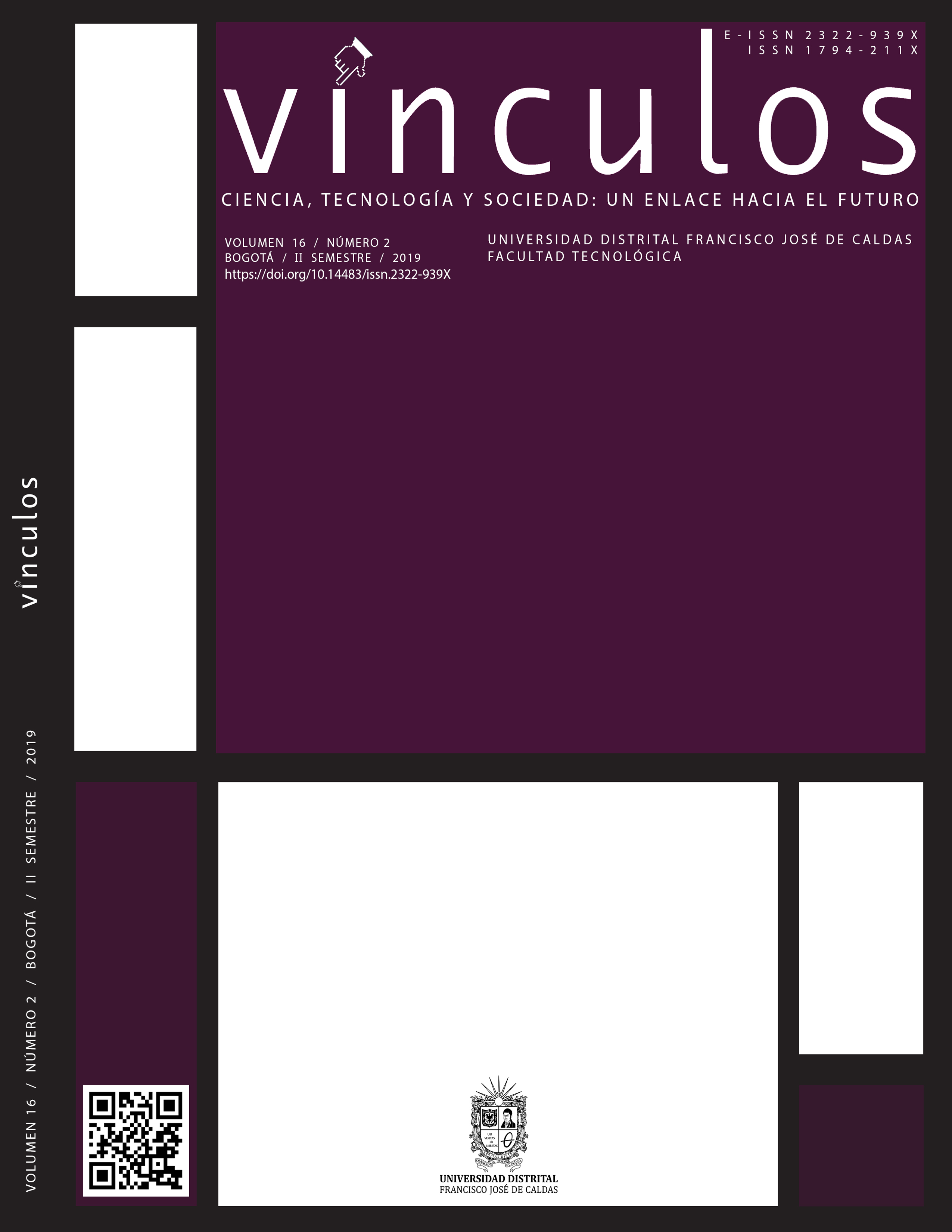DOI:
https://doi.org/10.14483/2322939X.16661Publicado:
2021-12-20Número:
Vol. 16 Núm. 2 (2019)Sección:
Actualidad TecnológicaAnálisis detallado del Standard IEEE 1459-2010 para sistemas eléctricos monofásicos lineales y no lineales
Detailed analysis of the IEEE 1459-2010 Standard for linear and non-linear singlephase electrical systems
Palabras clave:
IEEE Standar 1459, sistemas monofásicos lineales, sistemas monofásicos no lineales, potencia activa, potencia reactiva, factor de potencia, distorsión armónica (es).Palabras clave:
IEEE Standar 1459, linear single-phase systems, non-linear single-phase systems, active power, reactive power, power factor, harmonic distortion (en).Descargas
Resumen (es)
Este artículo tiene como objetivo mostrar el detalle del Standard IEEE 1459-2010 para sistemas monofásicos. Este Standard tiene como objetivo cuantificar la potencia de los sistemas eléctricos; sin embargo, no muestra el detalle de la deducción de las ecuaciones partiendo del esquema circuital. Por lo que la contribución de
este documento es la deducción paso a paso de las ecuaciones partiendo de los voltajes y corrientes del sistema. La deducción se realiza tanto para sistemas monofásicos lineales como para sistemas monofásicos no lineales. Se presenta el detalle del cálculo para la potencia activa, reactiva y aparente y también el cálculo del factor de potencia como de la distorsión armónica.
Resumen (en)
This paper amis to show the detail of the Standard IEEE 1459-2010 for single phase systems. The Standard IEEE 1459-2010 aims to quantify the power of electrical systems; however, it does not detail of the deduction of the equations from the circuit diagram. So the contribution of this document is the step-by-step deduction of the equations from the system's voltages and currents. The deduction is made for both linear single-phase systems and non-linear single-phase systems. The detail of the calculation for the active, reactive and apparent power and also the calculation of the power factor and harmonic distortion are presented.
Referencias
[1] S. Fryze, “Active, reactive and apparent power in non-sinusoidal systems”, Przeglad Elektrot., no. 7, pp.193-203, Polonia, 1931.
[2] C. I. Budeanu, “Reactive and fictitious powers”, Inst. Romain de l’Energie, Bucharest, Rumania, 1927.
[3] F. Buchholz, “Das begriffsystem rechtleistung. Wirkleistung, totale blindleistung”, Munich, Germany: Selbstverlag, 1950.
[4] IEC 60050 International Electrotechnical Vocabulary (IEV).
[5] IEEE Standard dictionary of electrical and electronics terms. ANSI/IEEE Std. 100-1988.
[6] L. S. Czarnecki, “What is wrong with the Budeanu concept of reactive and distortion power and why it should be abandoned”, IEEE Trans. on Instrumentation and measurement, vol. 36, pp. 1845-1854, Sept. 1987.
[7] L. S. Czarnecki, “Distortion power in systems with non-sinusoidal voltages”, IEE Elect. Power Applicat., vol. 139, pp. 276-280, 1992.
[8] D. Yildirim, E. F. Fuchs, “Commentary on various formulations of distortion power D”, IEEE Power Engineering, vol. 19, pp. 50-52, May. 1999.
[9] W. Shepherd, P. Zakikhani, “Suggested definition of reactive power for nonsinusoidal systems”. Proceedings of the Institution of Electrical Engineers, vol. 119, no. 9, pp. 1361-1362, Sept. 1972.
[10] N. L. Kusters, W. J. M. Moore, “On the definition of reactive power under non-sinusoidal conditions”, IEEE Trans. on Power Apparatus and Systems, vol. PAS-99, no. 5, pp. 1845-1854, Sept. 1980.
[11] Z. Nowomiejski, “Generalized theory of electrical power”, Arch. Elecktrotech, vol. 3, pp.177-182, 1981.
[12] C.H. Page, “Reactive power in nonsinusoidal situation,” IEEE Trans. on Instrumentation and Measurement, vol. 29, no. 4, pp. 420–423, Dec. 1980.
[13] P. Filipski, “A new approach to reactive current and reactive power measurement in nonsinusoidal systems,” IEEE Trans. on Instrumentation and Measurement, vol. 29, no. 4, pp. 423–426, Dec. 1980.
[14] H. Akagi, Y. Kanazawa, A. Nabae, “Generalized theory of the instantaneous reactive power in the tree-phase circuits,” Proceedings International Power Engineering Conference, pp. 1375-1386, 1983.
[15] H. Akagi, Y. Kanazawa, A. Nabae, “Instantaneous reactive power compensator comprising switching devices without energy storage components,” IEEE Trans. on Industrial Applications, vol. 20, pp. 625-630, 1984.
[16] J. L. Willems, “A new interpretation on the Akagi-Nabae power components for nonsinuoidal three-phase situations,” IEEE Trans. on Instrumentation and Measurement, vol. 41, pp. 523-527, Aug. 1992.
[17] S. Togasawa, T.Murase, H. Nakano, and A. Nabae, “Reactive power compensation based on a novel cross-vector theory,” IEEJ Trans. on Industrial Applications, vol. 114, pp. 340-341, March 1994. (En Japonés)
[18] F. Peng and J. Lai, “Generalized instantaneous reactive power theory for three-phase power systems,” IEEE Trans. on Instrumentation and Measurement, vol. 45, pp. 293-297, Feb. 1996.
[19] H. Kim, H. Akagi, “The instantaneous power theory on the rotating p-q-r reference frames”, Proceedings of the IEEE International Conference on Power Electronics and Drive Systems, PEDS '99. vol. 1, pp. 422-427, Jul. 1999.
[20] IEEE Working group in non-sinusoidal situations: Effects on meter of performance and definitions of power, “Practical definitions in systems with non-sinusoidal waveforms and unbalanced loads: a discussion,” IEEE Trans. on Power Delivery, vol. 11, no. 1, pp. 79-87, Jan. 1996.
[21] IEEE Standard Definitions for the Measurement of Electric Power Quantities Under Sinusoidal, Nonsinusoidal, Balanced, or Unbalanced Conditions, IEEE Std 1459-2010 (Revision of IEEE Std 1459-2000), pp. 1-40.
Cómo citar
IEEE
ACM
ACS
APA
ABNT
Chicago
Harvard
MLA
Turabian
Vancouver
Descargar cita
Visitas
Descargas
Licencia
Derechos de autor 2020 Revista vínculos

Esta obra está bajo una licencia internacional Creative Commons Atribución-NoComercial 4.0.
2.png)
Este obra está bajo una licencia Creative Commons Atribución 4.0





